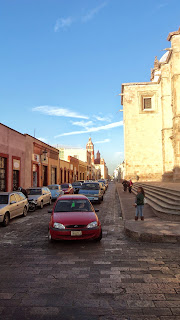Beside the ex Convent of San Agustin of Queretaro, of which we visited in this blog yesterday, which nowadays houses the MAQRO or Museum of Art of Queretaro, the Church of Saint Agustin, the building next-door, is still a functional building of the Catholic Church, where Mass and other Sacraments are offered everyday. In the XVIII and in the first half of the XIX centuries, both buildings were part of the same complex operated by the Order of Saint Augustine.
Façade of the Church of
San Agustin, Queretaro
Cornerstone of the Arch of the Main
Poetical with stone carved iconography
rich in spiritual meaning
View down the street of Pino
Suarez at the corner of Allende.
On the right you can see the steps
of Saint Agustin. A block down,,
you can see Santo Domingo on
the right hand side of the street.
Main Altar of Church of
San Agustin with flanking
Angels
Who was Saint Augustine? This blog is not the most appropriate place to write Saint Augustine's biography, but here are some facts about his life that most of you already know. He was born in the IV century, in Hippo, north Africa, son of a rich Roman noble and his mother was Saint Monica. Augustine converted to Christianity, and became the Bishop of his city. He became the most influential Christian Philosopher and Thinker of the early V Century, helping to merge doctrinal disagreements between many factions of the new growing Christian community. His Philosophy is considered by scholars in Theology to represent a Christian version of New Platonism, whereas, many centuries later, Thomas of Aquinas, would represent the new Christian version of Neo Aristotelian Philosophy.
Main aisle of Church with
flanking side altars.
Children's Choir of San Agustin
organizes concerts at Christmas time.
The church of San Agustin is like a beehive, with something special always happening. At Christmas time, the Children's choir and orchestra hold free concerts inside the church. During Lent, the ministers, mostly Augustinian priest, read the Gospels relating to the Birth of Jesus, and between readings, they play the Salter or Saltareio as it is called here.






No comments:
Post a Comment